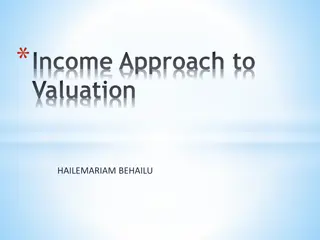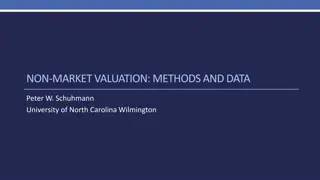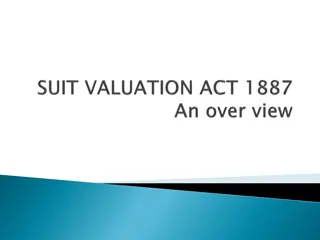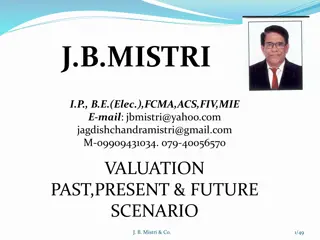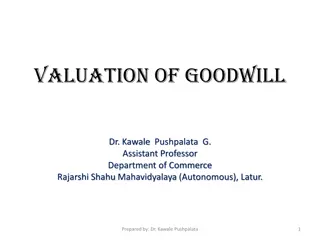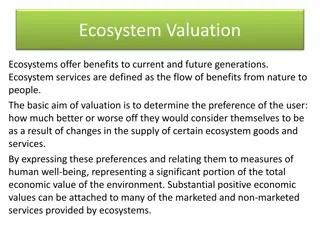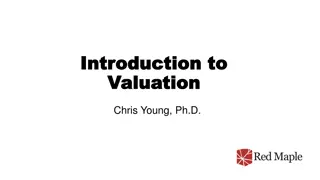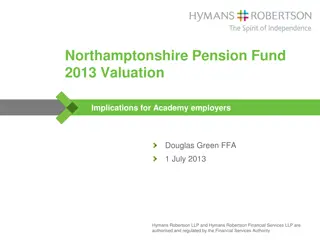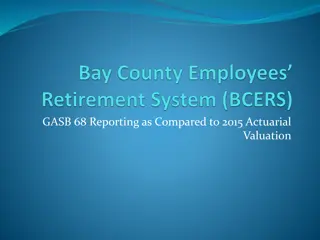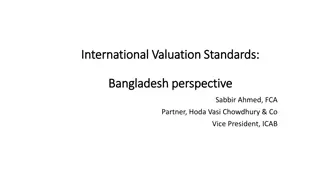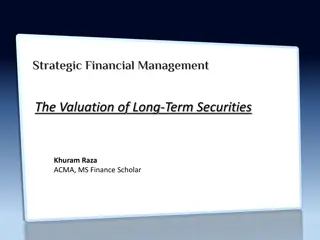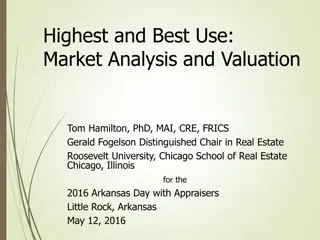Understanding Terminal Value in Valuation
Valuation of publicly traded firms with potentially infinite lives involves estimating cash flows for a growth period and a terminal value to capture value at the end. The stable growth rate, which cannot exceed the economy's growth rate, plays a crucial role in determining the present value of future cash flows. Factors like firm size, current growth rate, and barriers to entry influence when a firm reaches stable growth. Aswath Damodaran provides deep insights into estimating terminal value and the implications of stable growth rates in valuation.
Download Presentation

Please find below an Image/Link to download the presentation.
The content on the website is provided AS IS for your information and personal use only. It may not be sold, licensed, or shared on other websites without obtaining consent from the author. Download presentation by click this link. If you encounter any issues during the download, it is possible that the publisher has removed the file from their server.
E N D
Presentation Transcript
Getting Closure in Valuation A publicly traded firm potentially has an infinite life. The value is therefore the present value of cash flows forever. t = CFt (1+r)t Value = t =1 Since we cannot estimate cash flows forever, we estimate cash flows for a growth period and then estimate a terminal value, to capture the value at the end of the period: t = N CFt (1+r)t+Terminal Value Value = (1+ r)N t =1 Aswath Damodaran 1
Ways of Estimating Terminal Value Aswath Damodaran 2
Stable Growth and Terminal Value When a firm s cash flows grow at a constant rate forever, the present value of those cash flows can be written as: Value = Expected Cash Flow Next Period / (r - g) where, r = Discount rate (Cost of Equity or Cost of Capital) g = Expected growth rate This constant growth rate is called a stable growth rate and cannot be higher than the growth rate of the economy in which the firm operates. While companies can maintain high growth rates for extended periods, they will all approach stable growth at some point in time. Aswath Damodaran 3
1. How high can the stable growth rate be? The stable growth rate cannot exceed the growth rate of the economy but it can be set lower. If you assume that the economy is composed of high growth and stable growth firms, the growth rate of the latter will probably be lower than the growth rate of the economy. The stable growth rate can be negative. The terminal value will be lower and you are assuming that your firm will disappear over time. If you use nominal cashflows and discount rates, the growth rate should be nominal in the currency in which the valuation is denominated. One simple proxy for the nominal growth rate of the economy is the riskfree rate. Riskfree rate = Expected inflation + Expected Real Interest Rate Nominal growth rate in economy = Expected Inflation + Expected Real Growth Aswath Damodaran 4
2. When will the firm reach stable growth? Size of the firm Success usually makes a firm larger. As firms become larger, it becomes much more difficult for them to maintain high growth rates Current growth rate While past growth is not always a reliable indicator of future growth, there is a correlation between current growth and future growth. Thus, a firm growing at 30% currently probably has higher growth and a longer expected growth period than one growing 10% a year now. Barriers to entry and differential advantages Ultimately, high growth comes from high project returns, which, in turn, comes from barriers to entry and differential advantages. The question of how long growth will last and how high it will be can therefore be framed as a question about what the barriers to entry are, how long they will stay up and how strong they will remain. Aswath Damodaran 5
3. What else should change in stable growth? In stable growth, firms should have the characteristics of other stable growth firms. In particular, The risk of the firm, as measured by beta and ratings, should reflect that of a stable growth firm. Beta should move towards one The cost of debt should reflect the safety of stable firms (BBB or higher) The debt ratio of the firm might increase to reflect the larger and more stable earnings of these firms. The debt ratio of the firm might moved to the optimal or an industry average If the managers of the firm are deeply averse to debt, this may never happen The return on capital generated on investments should move to sustainable levels, relative to both the sector and the company s own cost of capital. Aswath Damodaran 6
4. What excess returns will you generate in stable growth and why does it matter? Strange though this may seem, the terminal value is not as much a function of stable growth as it is a function of what you assume about excess returns in stable growth. The key connecting link is the reinvestment rate that you have in stable growth, which is a function of your return on capital: Reinvestment Rate = Stable growth rate/ Stable ROC The terminal value can be written in terms of ROC as follows: Terminal Value = EBITn+1(1-t) (1 g/ ROC)/ (Cost of capital g) In the scenario where you assume that a firm earns a return on capital equal to its cost of capital in stable growth, the terminal value will not change as the growth rate changes. If you assume that your firm will earn positive (negative) excess returns in perpetuity, the terminal value will increase (decrease) as the stable growth rate increases. Aswath Damodaran 7
These are things (critiques) you should not worry about The terminal value is a high percentage of the estimated value of the firm today. Critics of DCF often argue that since the terminal value is a high percentage of the value today (80% or higher) that Your assumptions about the high growth period don t matter; this is not true since the base on which you compute your terminal value (earnings, cash flows) are affected by your high growth inputs DCF is flawed; Why? It reflects the reality that the bulk of your returns from buying stocks comes from price appreciation. The terminal value can be made as high as you want it to be, if you play with the growth rate. That is true, if you play with the growth rate. It is not true, if you follow the four rules we laid out. Bottom line: Tie growth to reinvestment and excess returns and cap your growth rate at the riskfree rate. Aswath Damodaran 8






